Joseph Leboit: Before “Tranquility”
INTRODUCTION
I was going to include a print by Joseph Leboit (American, 1907-2002) in a recap of print and book acquisitions during 2015. But this print has a bit of a story to tell because of all the clues found on the paper away from the image. At the same time I was seriously considering blurring that story because of a short article in January’s Maine Antique Digest. But now I’m forging ahead with the Leboit as a separate blog post.
Plastic Values
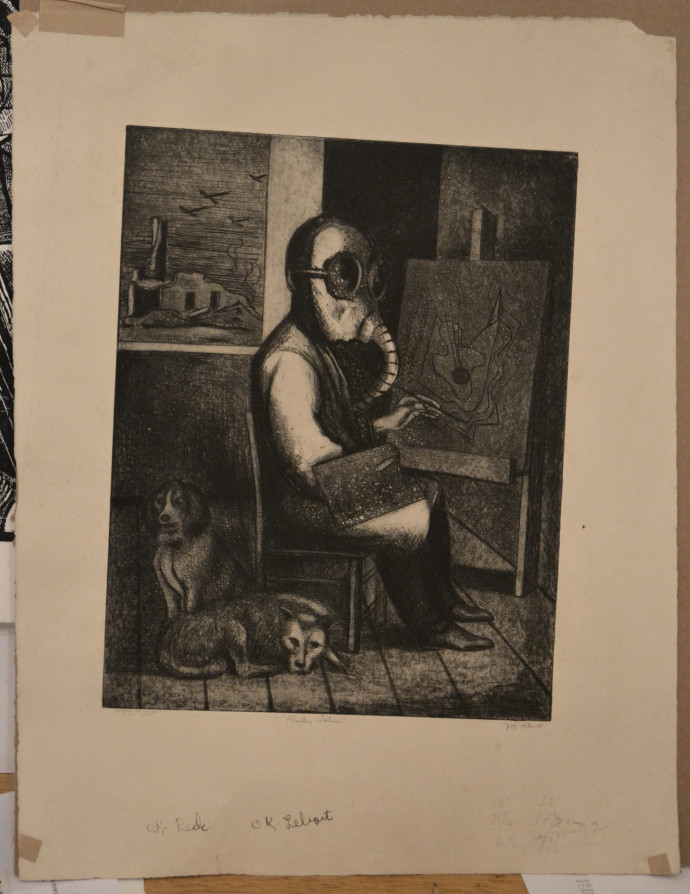
Joseph Leboit, Plastic Values, etching & aquatint, 1936, image 14″ x 10 7/8″ (All photographs by Scott Ponemone)
When I first viewed this print offered by Rachel Davis Fine Arts for its 12/12/15 auction I was struck by three anomalies: 1) the image was not centered on the paper; 2) the title Plastic Values did not match the published title Tranquility; and 3) the pair of OKs with signatures in ink well below the image. The clue to all of this, I believe, would be the Federal Art Project/WPA NYC stamp on the left below the image. But the stamp represented both a clue and a dilemma.
The dilemma arose because of an article on pg. 11-A of the January 2016 issue of Maine Antique Digest. Entitled “WPA Artwork Recovered from an Antiques Store and an Auction House,” the article related that agents of the U.S. Office of Inspector General seized a print listed on eBay and a painting from a California auction house. The print had a WPA stamp on front and a WPA label on back; the painting had a WPA stamp on the back. The article states, “Artwork produced under the federal Work Progress Administration during the New Deal era still belongs to the U.S. government.” Confiscated work, the article says, would be transferred to the General Services Administration’s Fine Art Program for placement in “a suitable public location.”
So I’m in very real danger of having the Leboit print seized by blogging about it. I considered telling its story without acknowledging the WPA stamp. I even Photoshopped out the stamp on a version of the image above. Yet many dealers of prints from this period clearly state which prints for sale have the WPA stamp. So I contacted one (whom I won’t name) and asked: “What is your understanding about ownership of prints bearing the WPA stamp? Has the GSA ever tried to seize a WPA-stamped print from you?” The response: “Hopefully the issue is dead and buried. The last I heard of anything was more than ten years ago and the issue disappeared. I prefer not to be quoted and would hope that you not do an article that might create additional problems.” Well that was off-putting. Then I talked to Rachel Davis on the phone. Her auction listing for the Leboit included mention of the WPA stamp. She said that she always indicates the presence of the stamp in her listings and has never had a problem. Her remarks boosted my confidence. So here I go ….
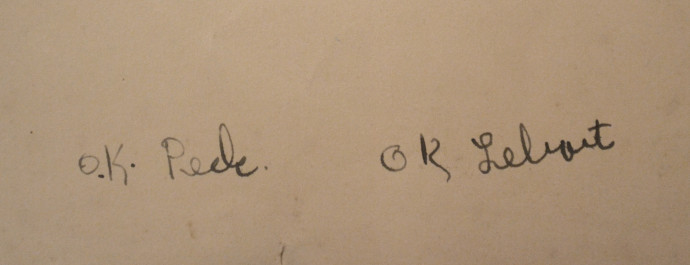
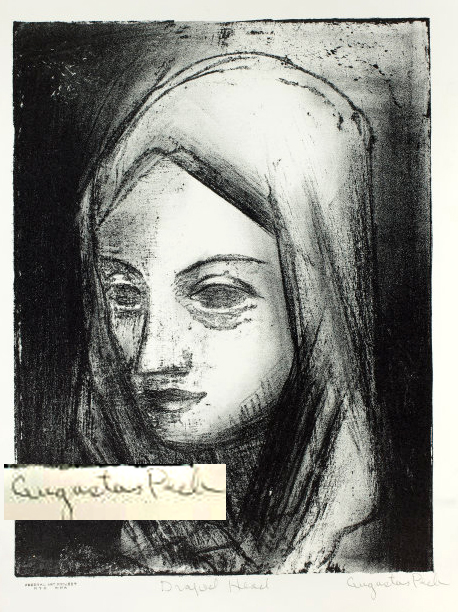
First I wanted to find out who OKed the print. Clearly the second OK reads Leboit; but who signed the first OK. Was the name Peele or Pede or something else? So I sought out information online about the New York WPA office and came across an article in the Massachusetts Review Spring, 1998 issue, written by fellow WPA printmaker Fred Becker. Unfortunately I could only see the first page of “The WPA Federal Art Project, New York City: A Reminiscence.” Then I called the Maryland Institute College of Art library to see if I could get access to their system online. But not being a student or faculty member, I couldn’t. Why can’t alumni have access, I wondered. Then the librarian did a great favor. He found the article and emailed me a PDF.
Becker wrote: “Lynd Ward resigned as supervisor, and sometime in 1936 Gustave Von Groschwitz succeeded him. … His assistant was Augustus Peck, a painter/lithographer, who was to become the first Director of the Brooklyn Museum Art School.” So the signature after the first OK was most likely Peck, not Peele or Pede.
To double check, I searched online for a Peck signature and found the print on the right. This image of a woman is a lithograph in the collection of the Art Institute of Chicago. It’s by Augustus Peck (American 1906-1975), called Draped Head. It bears the NYC WPA stamp. I’ve enlarged the signature. Even in it’s pixalated form, you can tell it matches the signature on the Leboit print.
For me, these OKs and the casual positioning of the paper when this impression was pulled indicate that my copy of this print was the bon à tirer (B.A.T.) for this edition. The glossary kept by the International Fine Print Dealers Association states: “Literally ‘ready to pull,’ the B.A.T. is the final trial proof-approved by the artist-which tells the printer exactly how the edition should look. Each impression in the edition is matched to or modeled after the B.A.T. This proof is used principally when someone other than the artist is printing the series. There is only one of these proofs for an edition.”
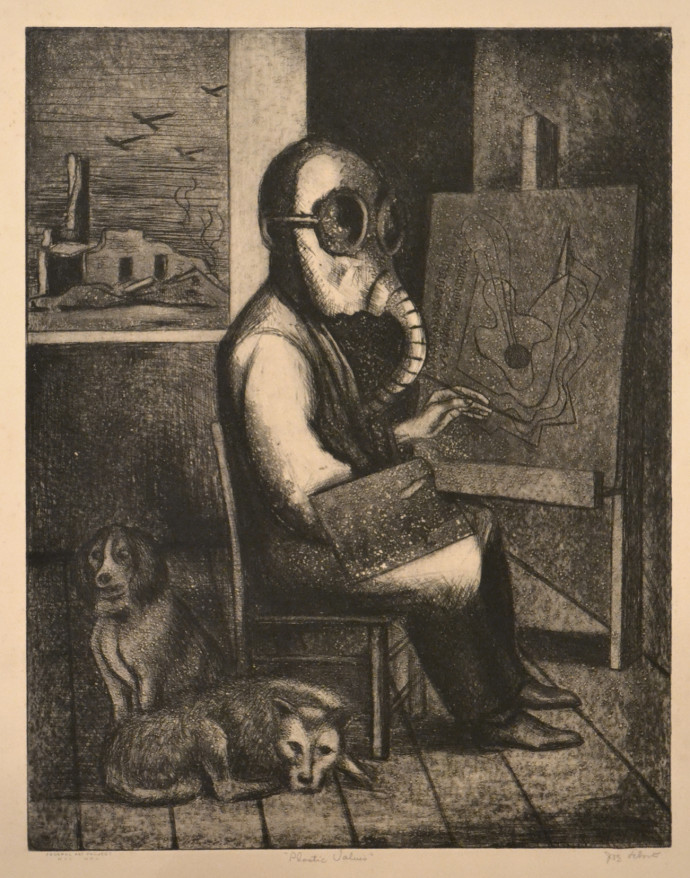
If indeed that my impression was the B.A.T. for the edition, it’s not surprising that the title Leboit gave at the time–Plastic Values–was not the one he used for the edition–Tranquility. As an artist I know that sometimes first stabs at a title aren’t the ones you keep.
And that about settles all three anomalies: 1) the image was not centered because that impression was not part of the edition and was not intended for distribution; 2) the title was just an initial attempt; and 3) the OKs are expected and needed for a B.A.T.
tranquility
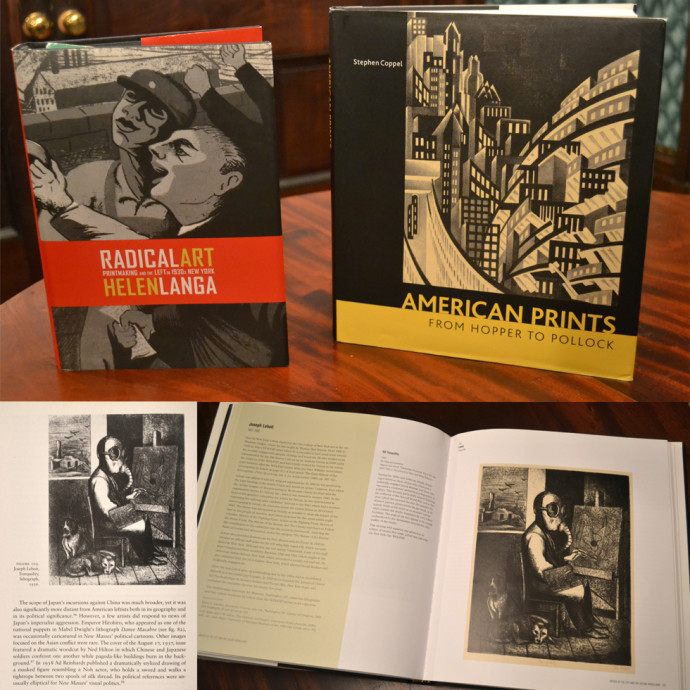
Two of my reference books on American printmaking feature Leboit’s Tranquility. They are Helen Langa’s Radical Art: Printmaking and the Left in 1930’s New York, University of California Press, Berkeley and Los Angeles, 2004 (top and bottom left) and Stephen Coppel’s American Prints: From Hopper to Pollock, Lund Humphries, Burlington, VT, 2008 (top and bottom right). Both authors comment on the print based on the Tranquility name. Coppel, Curator of the Modern Collection, Department of Prints and Drawings at the British Museum, first mentions the artistic debate that raged “between those artists who advocated a politically engaged Social Realism and those who espoused a modernist abstraction independent of politics.” Coppell says that in this print Leboit “satirizes the abstract painter, protected by his gas mask, as he quietly works at his easel on an abstract canvas while outside the studio warplanes fly over ruined buildings.” I emailed Coppel to see if his interpretation would change given that Leboit originally entitled in Plastic Values. He did respond but didn’t wish for his comments to be made public.
But Helen Langa, Associate Professor of Art History at American University, did. In her book she writes: “Indeed, in a lithograph [sic] sardonically titled Tranquility, Joe Leboit mocked artists who painted abstract works during a time of political crisis. … Although abstraction might convey revolutionary ideals through formal innovation, at a time of outright military aggression Leboit seems to ask, ‘Is that enough?’ ” In her response to my questions about the Plastic Values title, she said via email: “I do think the original title is very interesting. I suspect that Leboit, like Joe Vogel, had an ironic sense of humor along with their shared political interests. By calling that image Plastic Values, it seems to me that he may have wanted to suggest the ‘plasticity’ of moral responsibilities, to point out that some of his artist peers’ sense of honor, decency, and moral outrage were too easily co-opted by the call of abstractions painted in a studio walled off from the knowledge of what was actually going on in the world. However the larger audience of viewers might not so easily have understood the dual meaning of ‘plastic’ as used by art critics and artists, and perhaps he changed the title to one that made the same point in a less coded way. It certainly resonates for me today at the end of 2015 in even greater poignancy. What do you think?”
REader’s Comments
The first comment below is from Quentin Moseley, Professor of Printmaking at the Maryland Institute College or Art. Since he’s a printmaker, his comments are particularly cogent.
Trackback URL: https://www.scottponemone.com/joseph-leboit-before-tranquility/trackback/












impressive research – fascinating findings by a clever art slueth
Great Scott!
I now understand the newspaper reporter in you. What amazing research.
Not that all your blogs don’t have equal research. And great discussion about the importance of “title” and what it can do to
content interpretation.
I often don’t understand the true meaning of the artwork/print I am creating until I find the right title……part of the work/ thinking process as you develop the print. Printmaking, with the signing /curating of the print puts an emphasis on this chance to link left/right (speech/visual) brain coordination. There is a trend with some students/ and even teachers alike to downplay signing a work of art on the front….a tradition for printmaking which extends dramatically with the opportunity to provide meaning with a title (even one that is ambiguous) on the front as well.
So ….I always translate BAT as “good to pull” with the word “Bon”….perhaps little difference……though it is an assessment of the master printers’ skills , or the printing skills of artists themselves, at printing the print to bring out its content clarity. A high five…so to speak…the creative/image work is over ….so let’s get on with making some great prints of the image!
Q
Interesting and very thorough. Now I am thinking that I should take my unsigned proof out of its frame and see what, if anything, is written or stamped on its margins. I acquired it back in 2003 from Joe’s widow, Mollie Leboit. I visited with her and her son in California and looked through all the other prints, drawings and paintings that she dragged from the closet. I had come specifically for the “Tranquility” print. When I got back to LA I contacted my curator friend at the Art Institute of Chicago and he eventually acquired the prints for their collection. My print has a matt that may be covering who knows what. Never thought about it until reading this post. Molli died in 2014.
Kit,
Sorry for the delayed response. Nice that you bought Tranquility from Molli. (Too bad she’s deceased. Contacting her might have made for a great blog post). Did you ever check under the mat? (And if the mat isn’t acid free please update it).
Scott